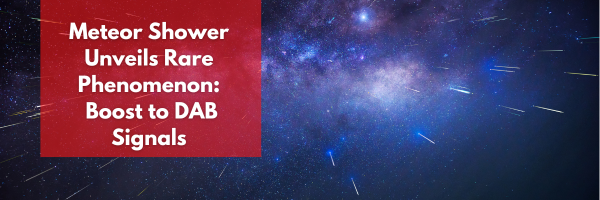
The night sky often looks incredible, but on the night of August 12, 2023, one Finnish DX (long-distance radio) enthusiast, Koe Kone, experienced an unexpected twist during the annual Perseids meteor shower. While gazing at the streaking meteors, Kone discovered a boost in German DAB (Digital Audio Broadcasting) signals, marking the first-ever documented instance of meteor-induced interference on VHF band III DAB signals.
Koe Kone, a dedicated DX hobbyist based in Turku, Finland, enjoys the challenge of seeking out distant broadcast signals. His YouTube channel showcases a treasure trove of recordings capturing broadcasts from across the Baltic Sea and beyond. However, it was during the meteor shower’s peak activity that Kone stumbled upon a radio phenomenon that had eluded detection until now.
The notion that atmospheric and celestial conditions can influence radio broadcasting is not a novel one. For decades, radio enthusiasts have observed the impact of meteor showers on radio signal propagation. Differences in the ionosphere between day and night have been known to affect the reach of AM signals, while temperature inversions in the troposphere can cause FM signals to ‘skip’ to distant markets.
As early as the 1930s, researchers recognised that meteor showers played a role in radio signal propagation. Enthusiasts and amateur radio operators have even used FM receivers to eavesdrop on meteor showers.
Kone’s groundbreaking discovery was made possible through his use of an Airspy Mini scanner and QIRX SDR software for signal reception. He paired these tools with a formidable 13-element VHF band III yagi antenna positioned at a lofty 48 meters above sea level. This setup allowed Kone to successfully receive and decode a signal emanating from a German multiplex operating in block 5C.
Intriguingly, Kone’s decoded stations led him to identify five potential transmission sources in Germany: Casekow, Pritzwalk, or Templin in Brandenburg; Röbel, Rostock, or Züssow in Mecklenburg–Vorpommern; and Garz on the picturesque island of Rügen, also situated in Mecklenburg–Vorpommern. Astonishingly, the closest of these sites is approximately 800 kilometers (nearly 500 miles) away from Kone’s reception site in southwestern Finland.
During the peak of his listening experience on August 12, Kone’s receiver displayed three adjacent DAB multiplexes on blocks 5B, 5C, and 5D. Although he couldn’t decode all the signals, he did capture brief bursts from blocks 5C and 5D in the early hours of August 11.
Sharing his discovery with the “DAB/DAB+ Digital & Online Radio” Facebook group, Kone reflected on his past successes in capturing Swedish DAB stations. However, the meteor shower recording was different. He noted, “This in the video was quite different, being a meteor scatter and lasted only a few seconds.”
Koe Kone’s discovery serves as a testament to the wonders that can be unveiled when technology, passion, and the mysteries of the cosmos converge. The meteor-induced boost to DAB signals not only adds a new layer of intrigue to the world of DX enthusiasts but also reminds us of the possibilities to discover. As we continue to explore the radio spectrum, who knows what other cosmic secrets may await discovery in the silent spaces between the stars?



Leave a Reply
Want to join the discussion?Feel free to contribute!